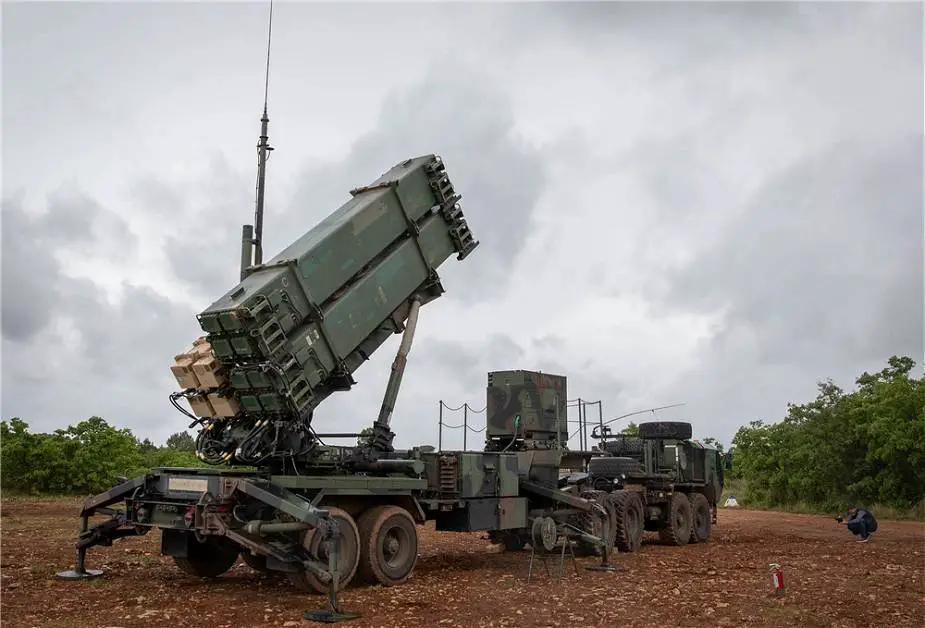- Army
- Conflicts in the world
- Israel - Iran conflict 2025
- Pakistan - India Conflict 2025
- Russia Ukraine War 2022
- Libya conflict day by day
- HAMAS - Israel War 2023
- Operation Serval in Mali French Army
- Sangaris operation Central African Republic
- Sangaris opération militaire République Centreafrique
- Ukraine - Russia conflict
- Syria conflict news
- Defence & Security Industry Technology
- Armies in the world
- Analysis Defense and Security Industry
- Conflicts in the world
- Navy
- Air
Analysis: US and German Patriot missiles for Ukraine provide long-range air defense capabilities
The United States and Germany will each deliver to Ukraine a PATRIOT air defense missile battery to counter the drone and missile attacks of the Russian armed forces. PATRIOT is one of the world’s most advanced air defense systems, and it will give Ukraine a critical long-range capability to defend its airspace.
Follow Army Recognition on Google News at this link

PATRIOT PAC-3 launcher unit of the U.S. Army 5th Battalion, 7th Air Defense Artillery Regiment. (Picture source U.S. DoD)
On December 21, 2022, the U.S. Department of Defense (DOD) announced that the United States would provide a PATRIOT battery to Ukraine as part of a larger $1.85 billion security assistance package. On January 5, 2023, Germany announced the delivery of one PATRIOT battery to Ukraine.
A PATRIOT battery costs about $1.1 billion, including about $400 million for the system and about $690 million for the missiles. The CSIS (Center for Strategic and International Studies) further suggests future U.S. PATRIOT battalions (U.S. PATRIOT battalions consist of four PATRIOT batteries) could cost up to $1.27 billion dollars apiece without missiles. PATRIOT missiles are estimated to cost about $4 million per missile.
The PATRIOT will complement a range of medium and short-range air defense capabilities of Stinger MANPADS and National Advanced Surface-to-Air Missile System (NASAMS)] that the United States has supplied as well as the other air defense systems provided by European countries including HAWK from Spain, and Crotale NG from France.
Training courses for Patriot operators and maintainers normally take many months. The PATRIOT system repairer course, for example, takes 53 weeks. The fire control operator course is 20 weeks. The launch system operator course is 13 weeks. Ukraine could save time by sending soldiers which are operators of the Russian-made S-300 air defense missile system, which Ukraine has operated for many years.
The PATRIOT is the acronym for Phased Array Tracking Radar to Intercept Target. The first test-lanched of the Patriot was conducted in 1970 and the first production systems were delivered to the US Army in June 1982 and a follow-on test and evaluation program were conducted in 1983.
The Patriot air defense system is manufactured by the American company Raytheon while the missiles are produced by Lockheed Martin. Since its introduction in 1982, the Patriot missile has undergone many improvements to increase its capabilities to intercept modern aerial threats such as drones, aircraft, helicopters, and ballistic and cruise missiles.
A PATRIOT battery has six major components including a power plant [two vehicle-mounted 150 kilowatt (KW) generators], radar set, engagement control station, launcher stations, antenna mast group, and interceptor missiles (PAC-2s and PAC-3s). A PATRIOT battery (the basic firing unit) consists of about 90 soldiers, but three soldiers in the engagement control station are the only military personnel required to operate the battery in combat.
The PATRIOT’s phase-arrayed radar system has a range in excess of 150 kilometers (km) and the capacity to track up to 100 targets, providing missile guidance data for up to nine missiles. The flight ceiling for PATRIOT missiles is about 20 km and PATRIOT can provide area coverage and defense for about 15 to 20 km for incoming ballistic missiles.


























